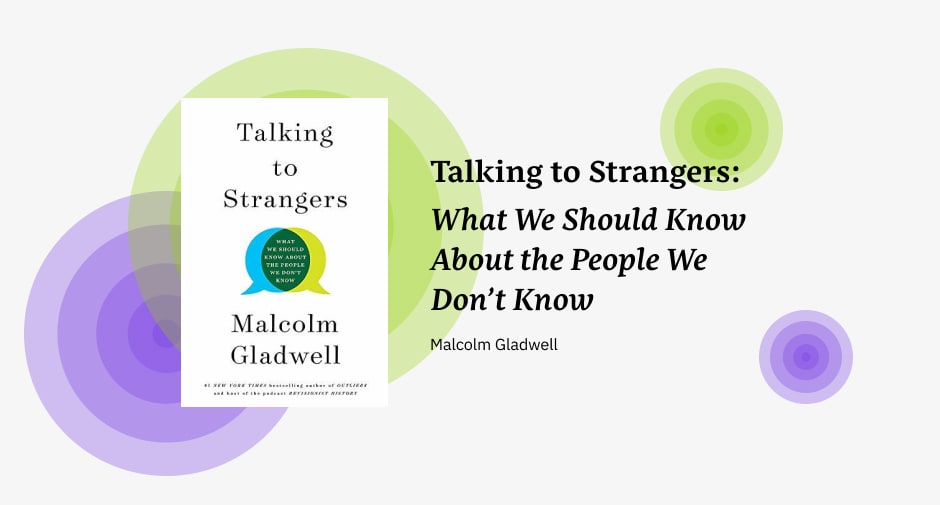Encountering truth, transparency, and coupling in business
Recently, I read a book from Malcolm Gladwell and today I want to share some of my observations on how some of his concepts are applicably in my line of business.

Lessons from Gladwell’s book “Talking to strangers”
Even though I do not find myself as an avid book reader, from time to time I like to pick an insightful read with the goal to broaden my horizon.
In this quest, Goodreads network helps me a lot with personally tailored recommendations. During this winter I came across Malcolm Gladwell, an award-winning writer, and his book Talking to Strangers. You can go on and explore his opus and career but I won’t go into that alley.
What piqued my interest is the way he speaks about the concepts of truth, transparency & coupling. Even though the author connects the concepts with historic events and prominent people, I couldn’t refrain from relating them to my daily interactions with existing and potential clients. I will go through each of the mentioned concepts and express the relevance I found intriguing!

Defaulting to truth
Essentially, defaulting to truth is a way of giving people the benefit of the doubt, assuming that they are being honest unless we have clear evidence to the contrary.
The author argues that this tendency is rooted in our social nature and our desire to trust others in order to build relationships and maintain social cohesion. Couldn’t agree more! When encountering people from the other side of the table I am usually positive and trustful by default.
From my personal position as a project manager I see that this has a grounding in the fact that the project is derived from a pre-sales business process, in which, again, I have full trust.

While this tendency can be a positive trait, it can also lead to possible misunderstandings and miscommunications. Especially when we encounter people who may be intentionally deceptive or dishonest. We all have that one client with whom we started a good relationship and ended in a bitter business-to-business relationship because the understanding wasn’t mutual, and sometimes even truthful.
In this sense, I would argue that it is vitally important to try and understand people that represent the client and relevant stakeholders. Their surroundings, culture, generational differences, and other impactful factors. Only then, we can seek to understand each other toward building a meaningful relationship.
An illustrative example would be one of the bloodiest conflicts of the sixteenth century between the Spaniards and the Aztecs. Just because Hernan Cortes, Spanish conquistador, didn’t know anything about ruler Montezuma II (whom he met when he landed on an exploratory mission to Mexico) the bloodiest conflict emerged just on the basis of misunderstanding.
What happened was that in Aztec culture, when speaking in a high court, the speaker was obliged to say the opposite of what was really meant. True meaning was embedded in the use of reverential language. This tradition was supposed to project status through elaborate false humility. Montezuma used the word teotl to refer to Cortes and his men, which the Spanish translated as god. Also, he spoke of himself as small and weak, which, in other words, meant he was actually subtly drawing attention to the fact that he was esteemed and powerful. The Spaniards, by wrongly translating, recognized the speech as Montezuma’s surrender, while it was actually the opposite, it was his acceptance of a Spanish surrender. The misunderstanding easily and quickly escalated into the massacre.
Similarly, although without blood, conflicts emerge based on misunderstanding, and long-term project goals are jeopardized.
As mentioned earlier, we tend to default to the truth that we understand. It is a deeply ingrained part of human nature, but we need to be aware of its limitations and be willing to question our assumptions in certain situations, particularly when we’re dealing with people we don’t know well or in high-stakes situations.
Transparency
The concept of transparency refers to the idea that people’s emotions and intentions are easily readable and understandable to others.
Gladwell argues we often assume that we can “read” people accurately based on their facial expressions, tone of voice, and other nonverbal cues.
We assume that when someone is smiling, they’re happy, and when they’re frowning, they’re upset. Similarly, we assume that when someone says something, they mean what they say and that their words accurately reflect their intentions.

He points out that people are often better at masking their emotions than we give them credit for, and that the meaning of our words can be easily misinterpreted or misunderstood by others.
He cites several examples to illustrate this point.
Amanda Knox case
One is the case of Amanda Knox, the American exchange student who was wrongly convicted of the murder of her roommate in the quiet town of Perugia in Italy. She was a prime suspect, considering she was first on the crime scene to call the police. Not to mention her flat was covered in their DNA, which was logical. After all, they were roommates. After not finding any concrete evidence, Amanda was found guilty mostly because in court, in front of the jury, she acted as if she didn’t care about her friend being gruesomely murdered (slit throat, semi-naked, blood everywhere). Rather, she was being very immature and relaxed. This led to the Italian Supreme Court convicting her of murder. Only after eight years after the crime and continuous investigations the Court declared her innocence.
Munich Agreement case
The other example is the misinterpretation of a conversation between Neville Chamberlain and Adolf Hitler in 1938, which led to the disastrous Munich Agreement.
In their talk, Hitler made it plain that he was going to seize the Sudetenland, regardless of what the world thought. Chamberlain wanted to know whether that was all Hitler wanted. Hitler said it was. The next morning, back in England, Chamberlain gave a quick speech on the tarmac of Heston Airport expressing his satisfaction and understanding between Hitler and him.
Unfortunately, he fell under Hitler’s spell, being outmaneuvered at the bargaining table, misreading Hitler’s intentions. He failed to warn Hitler that if he reneged on his promises that there would be serious consequences. Chamberlain’s negotiations with Hitler are widely regarded as one of the great follies of the Second World War.
Taking these examples into account we need to be cautious about assuming that we can accurately read others’ emotions and intentions.
In project management, there are many hard skills that ensure that we have factual evidence to either confirm or deny our assumptions. Take, for example, notes from the meeting (also referred to as meeting minutes). They often contain information as to how the client reacted when presented with a certain situation.
Afterward, the client is presented with the written material to once again verify the understanding of all the key points of the conversation. This process ensures that there is less room for misinterpretation. However, sometimes we have to depend on our soft skills and lean on our own assumptions and interpretations. It may be necessary to engage in more explicit and transparent communication to ensure that everyone is on the same page. Makes you think!
Coupling
Coupling refers to the idea that people’s behavior is strongly influenced by the environment or situation in which they find themselves.
Gladwell argues that humans are not inherently good or bad, but rather that our behavior is heavily influenced by the context in which we find ourselves.

The example that astonished me is the relationship between suicide rates that happened on the Golden Gate Bridge and the drastic lowering of the same after the suicide net was made (shockingly, after 81 years of its existence, in 2018).
You would now probably say that those wanting to commit suicide will do it eventually, regardless of the means. Incorrect! According to a clever bit of detective work by psychologist Richard Seiden, who followed up with 515 people who tried to jump from the bridge, only 25 of these 515 persisted in killing themselves some other way.
But let’s hit the brake there.
What does this have to do with business conduct?
In these post-covid days it has become a regular practice to have online meetings and actual face-to-face meetings came to an all-time low. This might be crucial to consider, especially on the first encounter. It is not only clever but also respectful, to schedule the first project meetings in person (eg. kick-off meeting).
Not only that physical presence emphasizes commitment and goodwill, but it also gives us an opportunity to observe the other side’s behavior in either their own environment or the way of adjusting to a new (our) environment.
These small non-verbal observations can give us an insight into the preferred way of business conduct. Basically, we need to be aware of the powerful influence that context and environment can have on our and our client’s behavior. We cannot assume that behavior is solely a result of individual character or personality; instead, we need to consider the broader social, cultural, and environmental factors that may be contributing to making different actions.
By doing so, we may be better equipped to understand and address more complex problems when we tackle them!
In conclusion
To summarize, we need to be aware that people have a tendency to default to truth but at the same time question our subjective assumptions. We have to lean towards explicit engagement to contribute to more transparent communication, all in the environment that suits best all the involved parties!
Also, we still need to be observant of individual behavior coupled with their social, cultural, and environmental factors.
When writing about it, it seems like a bit of a broad field of things to consider and take into account over the course of a simple initial meeting with the client, but I am confident that if practiced regularly it can become a standard good practice.

The crucial differential factor among many managers is their soft skills. Polishing them on a regular basis gives us higher value, especially in the field of ease of business conduction. Consider these two types of relationships with a company. With one, you have a high level of understanding but their speed of delivery is not satisfactory. Other you can barely understand but they make quick but faulty deliveries. What does it matter if the job is done quickly if it is not what was required…
Using your soft skills to be agile in the tendency of defaulting to truth and backing them up with good practices to establish transparent relationships will contribute to the quality of business relationships. If taking all the mentioned factors into consideration, it is quite possible to provide a high-quality delivery in a timely manner!
Let’s chat
Are you interested in being a part of an experienced team that works on world-class products? Jump to our Careers page and apply. We will help you grow your development, engineering, and soft skills.
Or maybe you have a great idea for a product and want to make it a reality? If you are unsure what the best next steps you need to take to deliver user-friendly products, reach out to us to schedule a free consultation with our experts. We’ll guide you through the whole process.